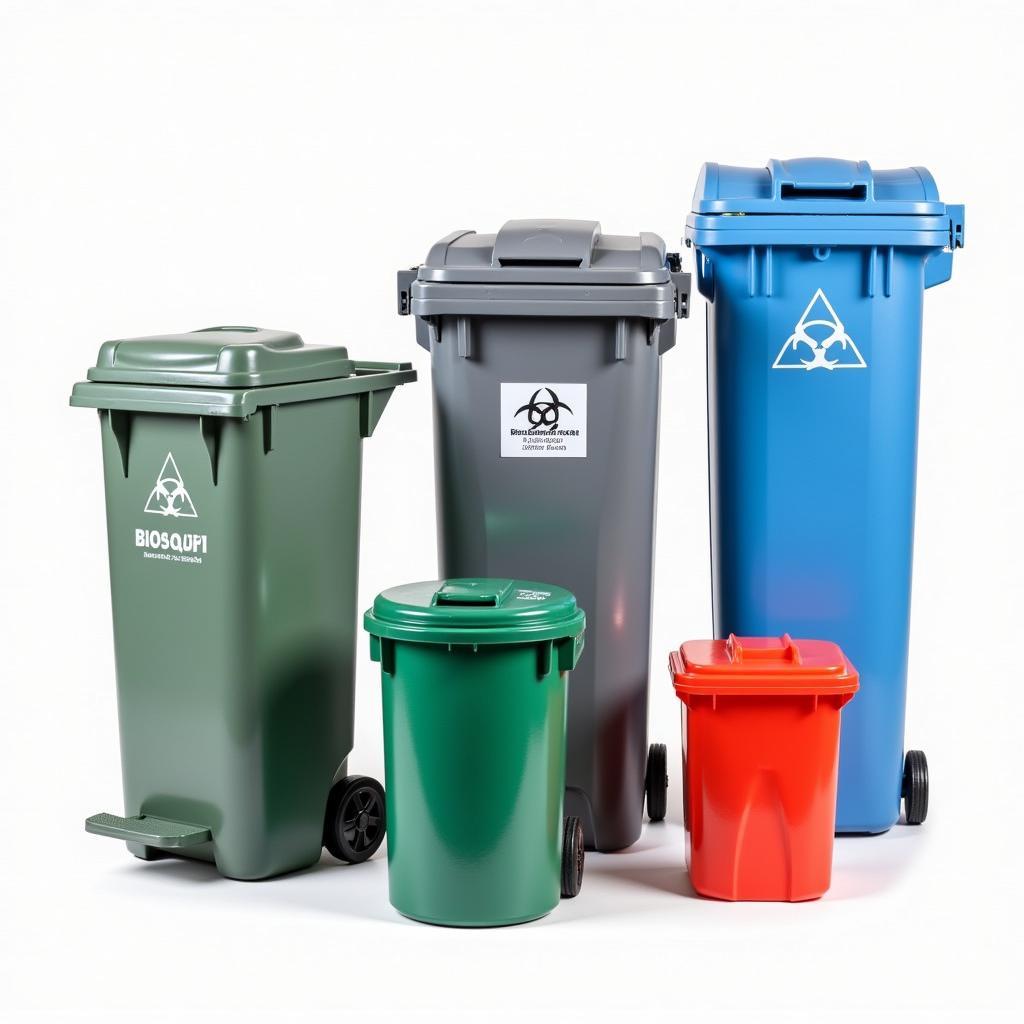Hospital Garbage Cans are more than just receptacles for waste. They are essential components of a healthcare facility’s hygiene and infection control strategy. Effective waste management is critical in preventing the spread of infections, protecting patients and staff, and maintaining a clean and safe environment.  Hospital Garbage Can Hygiene and Infection Control
Hospital Garbage Can Hygiene and Infection Control
The Importance of Proper Hospital Garbage Can Selection
Choosing the right garbage can is crucial for various reasons. Different types of waste require specific disposal methods, and selecting the appropriate can ensures compliance with regulations and minimizes the risk of contamination. hospital garbage cans are designed with specific features to address the unique challenges of a healthcare setting. For example, sharps containers are designed for safe disposal of needles and other sharp medical instruments, preventing accidental needlestick injuries. Similarly, biohazard waste requires specialized containers that are clearly marked and prevent leakage.
What factors influence garbage can selection? Size, material, and features play a vital role. A smaller room might require a compact garbage can, while a larger area might benefit from a larger capacity bin. The material of the can should be durable, easy to clean, and resistant to chemicals commonly used in healthcare settings. Features like foot pedals, swing lids, and automatic sensors can further enhance hygiene and ease of use. Selecting the right garbage can isn’t just about practicality; it’s an investment in patient and staff safety.
Different Types of Hospital Garbage Cans
Hospitals utilize various types of garbage cans to accommodate different waste streams. Understanding the specific purpose of each type is essential for maintaining a hygienic environment.
- General Waste: These cans are used for everyday waste that isn’t contaminated with bodily fluids or hazardous materials.
- Biohazard Waste: These specialized containers are designed for waste contaminated with potentially infectious materials, such as blood, bodily fluids, and contaminated dressings. They are typically red or orange and clearly labeled with the biohazard symbol.
- Sharps Containers: These puncture-resistant containers are specifically for the disposal of needles, scalpels, and other sharp medical instruments. Their design helps prevent needlestick injuries and the spread of bloodborne pathogens.
- Recycling Bins: Promoting sustainability in healthcare, these bins are designated for recyclable materials like paper, plastic, and glass. They are usually clearly marked with recycling symbols and instructions.
Maintaining Hospital Garbage Cans: Best Practices
Keeping hospital garbage cans clean and in good working order is essential for infection control. Regular cleaning and proper liner usage are key to preventing the build-up of bacteria and unpleasant odors.
How often should hospital garbage cans be cleaned? High-touch surfaces, including garbage can lids and foot pedals, should be disinfected frequently throughout the day. Liners should be changed regularly, and the cans themselves should be thoroughly cleaned and disinfected on a regular schedule. What cleaning solutions are recommended? Hospital-grade disinfectants are essential for effectively eliminating pathogens. hospital garb plays a significant role in protecting staff during the cleaning process, preventing cross-contamination.
“Maintaining a clean environment isn’t just about aesthetics, it’s about patient safety. Proper garbage can hygiene is a vital component of infection control in any healthcare facility,” says Dr. Amelia Hernandez, Infectious Disease Specialist at San Jose Hospital.
The Role of Hospital Garbage Cans in Infection Control
Effective waste management, including the proper use and maintenance of garbage cans, plays a crucial role in preventing healthcare-associated infections (HAIs). By containing contaminated materials and preventing their spread, hospital garbage cans contribute significantly to a safer environment for both patients and healthcare workers.
“Every detail matters when it comes to infection control. Hospital garbage cans might seem like a small thing, but their proper use can have a big impact on preventing the spread of disease,” adds Dr. Michael Chen, Chief of Staff at San Jose Hospital.
In conclusion, hospital garbage cans are more than just receptacles for waste; they are vital tools in maintaining a hygienic and safe healthcare environment. By selecting the appropriate cans, adhering to best practices for their use and maintenance, and understanding their role in infection control, hospitals can significantly reduce the risk of infection and promote a healthier environment for everyone.
FAQ
- What are the different types of hospital garbage cans? General waste, biohazard, sharps, and recycling.
- How often should hospital garbage cans be cleaned? High-touch surfaces frequently, liners regularly, and cans thoroughly on a schedule.
- Why are sharps containers important? They prevent needlestick injuries.
- What is the role of hospital garb in garbage can maintenance? It protects staff during cleaning and prevents cross-contamination.
- How do hospital garbage cans contribute to infection control? By containing contaminated materials and preventing their spread.
- What type of waste goes in a biohazard bin? Waste contaminated with potentially infectious materials like blood or bodily fluids.
- Why is it important to choose the right size garbage can? To accommodate the volume of waste in a specific area.
Need support? Contact us at Phone: 02437655121, Email: [email protected] or visit us at 298 Cau Dien St., Minh Khai, Bac Tu Liem, Hanoi, Vietnam. We have a 24/7 customer service team.